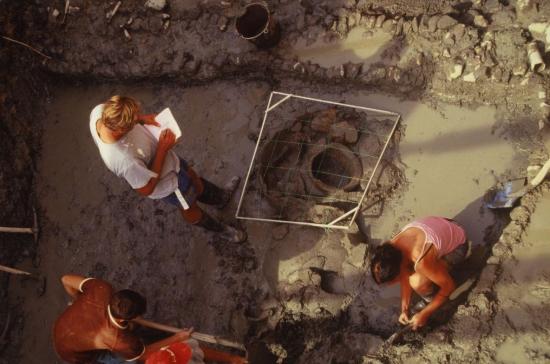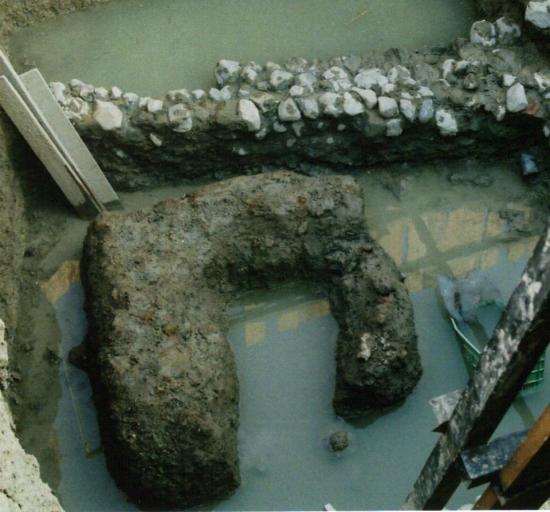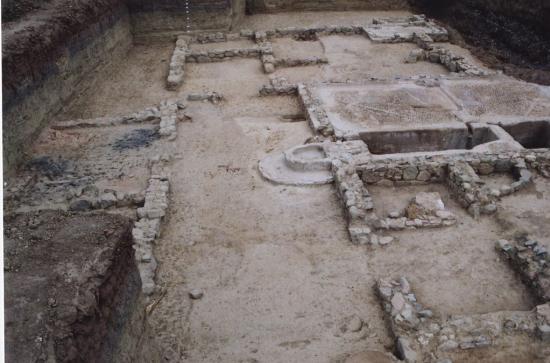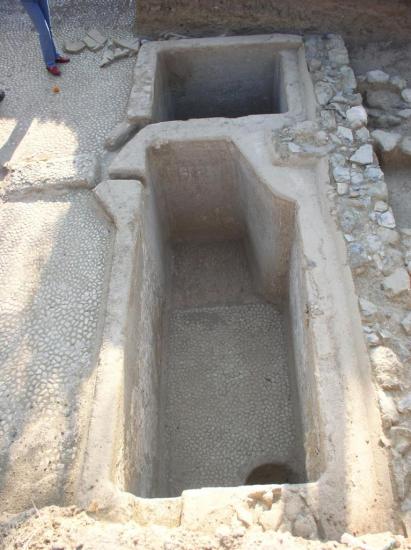Helike : the prehistoric and classical capital of ancient Achaea
Source - http://www.helikeproject.gr/
In the winter of 373/372 BC, a violent earthquake struck the southwest shore of the Gulf of Corinth and destroyed and submerged the Classical city of Helike. Helike was founded in the Mycenaean period by Ion, the leader of the Ionian race and became the capital of the Twelve Cities of ancient Achaea. The patron god of Helike, Poseidon Helikonios, god of the sea and the earthquakes, was worshipped in his famous pan-Hellenic sanctuary located in the area of Helike. In the 8th c. BC, Helike founded Sybaris in South Italy, the most famous Greek colony of the West. The city of Helike remained important in the Archaic and Classical periods until it was destroyed and lost by the earthquake of 373 BC, widely discussed by many ancient writers. Few decades before its destruction, Helike struck her own coinage. Three bronze coins of Helike are known --two in the Berlin Museum, a third recently auctioned in Vienna--, showing on the obverse a fine Classical head of Poseidon and on the reverse the trident flanked by two dolphins in heraldic position.
Eratosthenes, a philosopher and mathematician of the 3rd c. BC, visited the area of Helike about 150 years after its destruction and talked with ferrymen who recounted to him the story of the bronze statue of Poseidon submerged in the poros. The term poros generally interpreted as indicating the Corinthian Gulf, was rightly re-interpreted by Katsonopoulou as referring to a lagoon formed in the area of Helike following the seismic event of 373 BC. The lagoon which Eratosthenes saw in the 3rd c. BC, had become partly dry land when the traveler Pausanias visited the site in the 2nd c. AD. In the remaining part of the lagoon, however, one could still see submerged ruins of the city, as Pausanias reports. The mention of submerged ruins in the area of Helike persists until the Middle Byzantine period (9th-10th c. AD). Today, the entire area of the ancient lagoon is completely covered under river-borne sediments.

The Helike Delta, viewed toward the southeast, with the Gulf of Corinth at left.
Systematic excavations of the Helike Project started in 2000. The first trial trenches opened on the basis of evidence from topographical studies, bore holes and geophysical surveys, revealed buried remains in various locations along the plain dated on the basis of the excavation finds to the Early Bronze Age, Late Bronze Age, Geometric, Classical, Hellenistic, Roman and Byzantine periods. Continuation of our excavations between 2001-2011 resulted in a number of important discoveries in the Helike area.
The Early Helladic settlement. In the middle of our area of investigations, in the contemporary village of Rizomylos, we brought to light the remains of a well-preserved coastal EH settlement, the first ever found in Achaia. Large rectilinear buildings flanking the sides of cobbled streets, including a rare type of building known as “corridor house”, came to light preserving their rich contents, especially the pottery, intact. The assemblage of associated pottery includes a variety of shapes, such as two-handled bowls (kraters), pedestal-footed cups, cooking pots, narrow-necked jars, bass bowls, rim-handled and neck-handled tankards, flat-based cups, jugs, pyxides, wide-mouthed jars, one-handled and two-handled cups, and large pithoi decorated with finger-impressed, rope and overlapping disk bands decorations. Decorated pottery includes solidly painted and pattern-painted decoration Dark-on-Light with intersecting horizontal and vertical lines, zigzag, cross-hatching and paneled patterns. Incised “potter’s marks” were found on pottery fragments. Remains of seeds were found inside some of the recovered vases. Among the rich pottery assemblage, we also discovered a rare drinking cup, a depas amphikypellon, with an engraved symbol above its base. Our EH finds also include pointed bone tools, stone tools, objects of obsidian and flint for cutting and scraping activities, and terracotta objects, such as spindle whorls and spools. We also collected a great number of sea shells and animal bones.Νew outstanding walls, 0.80 m wide, preserved to the impressive height of 1.10 m came to light with the 2011 excavations at the EH site in Rizomylos. Recovered pottery was once again amazingly abundant including complete vases.

Other finds from the excavated rooms include terracotta spindle whorls, stone tools, chipped stone artifacts, sea shells and animal bones. Among the most significant new finds from the EH settlement in 2011, we note an exceptional architectural feature found in one of the excavated rooms. It is a thick-walled, pi-shaped clay structure, 0.70 m high, found in a room where many storage vessels were discovered arranged in clusters around and near it suggesting that it might have served as a storage closet of some kind.

The sediments covering the EH horizon contain numerous marine microfauna, showing that the ruins were submerged in the sea for some time. Excavation evidence suggests that the EH settlement was destroyed and submerged by an earthquake accompanied by extensive fire. Then, the site was abandoned and left with its content intact, sealed under thick clay deposits.
The discovery of a rich organized coastal EH settlement at Helike as shown by its finds (substantial architectural remains, intact rich pottery, and luxury finds in gold and silver) renders her region to a location of great importance for the history and archaeology of Achaea. It is now evident that the same general location where the most important city of Achaea was built in the Mycenaean period, had been the place where a most significant settlement of the Early Bronze Age flourished a thousand years earlier. Undoubtedly, the complete excavation of the EH settlement at Helike will offer a rare opportunity for prehistoric Greece to reconstruct an Early Bronze Age settlement and study its everyday life and also the economy of the era.
The Hellenistic industrial site. Excavation of trenches in Valimitika in the western area of investigations, brought to light the well preserved architectural remains of a large industrial building consisting of a complex of large basins with pebble mosaic floors in its center surrounded by habitation areas, workshops and storage areas. Associated finds from the building are rich and include a large array of Early-Middle Hellenistic pottery including black glazed, red glazed, and relief decorated vases. Other finds include clay lamps, clay loom weights, bronze coins, and objects in bronze, iron and lead. Excavation data suggest that the building probably belongs to a Hellenistic Dye-Works complex. In several locations to the south and west of the complex building, we discovered the remains of other Hellenistic buildings and walls.

 PART. 2
PART. 2